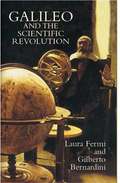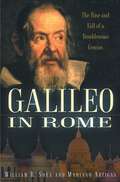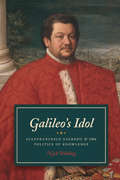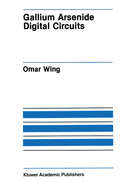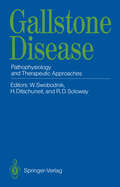- Table View
- List View
Galbraith's Building and Land Management Law for Students
by Michael Stockdale Rebecca Mitchell Stephen Wilson Simon Spurgeon Russell Hewitson Mick WoodleyIdeal for first year Undergraduate students taking law modules on Construction, Surveying, Planning and Engineering courses, Galbraith’s Building and Land Management Law for Students is an excellent overview of the key legal issues in the construction industry. Clearly written and wide ranging coverage of key legal principles by construction lecturers and professionals, this textbook highlights the need for students on construction related courses to access information on how the law relates to them, without getting into the dry, heavy detail of the full scale legal texts. This sixth edition has been fully updated and covers the latest JCT Standard Form Building Contract requirements and key EU directives, including Corporate Manslaughter, Employment Law, Tenant Planning Law regulations and Health and Safety acts.
Galbraith's Building and Land Management Law for Students
by Michael Stockdale Rebecca Mitchell Stephen Wilson Simon Spurgeon Russell Hewitson Mick WoodleyIdeal for first year Undergraduate students taking law modules on Construction, Surveying, Planning and Engineering courses, Galbraith’s Building and Land Management Law for Students is an excellent overview of the key legal issues in the construction industry. Clearly written and wide ranging coverage of key legal principles by construction lecturers and professionals, this textbook highlights the need for students on construction related courses to access information on how the law relates to them, without getting into the dry, heavy detail of the full scale legal texts. This sixth edition has been fully updated and covers the latest JCT Standard Form Building Contract requirements and key EU directives, including Corporate Manslaughter, Employment Law, Tenant Planning Law regulations and Health and Safety acts.
Galileo and the Scientific Revolution
by Laura Fermi Gilberto BernardiniAn absorbing account of the origins of modern science as well as a biography of the revolutionary thinker, this inspiring book was co-written by a former director of the Italian Institute for Nuclear Physics and a historian of science (who was also the wife of physicist Enrico Fermi). It begins in Galileo's youth, with his return to his native city of Pisa to train as a physician. Instead, the student became captivated by the power of mathematical reasoning — an interest that led him to apply mathematical logic to natural events and, ultimately, to invent the concept of experimentation. Galileo's progress from student to teacher to scientific innovator is traced, with particular emphasis on his experiments with building and refining telescopes and his unprecedented observations of the moon and planets. The dramatic results of his findings, including his refutation of Aristotelian theory and his support of Copernican doctrine, are related in full, along with his clash with the papal inquisition and his tragic demise under house arrest. Written with a warm appreciation for the wonders of Galileo's achievements and with impeccable scholarship, this book concludes with a survey of the scientist's remarkable legacy. 12 figures. Appendix. Bibliography. Index.
Galileo Galilei (Biographien hevorragender Naturwissenschaftler, Techniker und Mediziner #19)
by Ernst SchmutzerGalileo Galilei kontrovers: Ein Wissenschaftler zwischen Renaissance-Genie und Despot
by Walter HehlWalter Hehl eröffnet in seinem Buch einen neuen Blick auf die Person Galileo Galilei und dessen Leistungen – sowohl im Kontext der Wissenschaft im Zeitalter der Renaissance als auch aus Sicht der heutigen Physik. Dies ermöglicht Lesern eine bessere Einschätzung der Epoche und ein gesteigertes Verständnis der Geschichte um Galilei. Der Autor greift die neue Sichtweise auf, in der Galilei vom wissenschaftlichen „Heiligen“ zu einer wenigstens teilweise umstrittenen Person geworden ist. Eine Zeittafel mit Kontextdaten sowie ein Glossar fassen zentrale Begriffe und Eckdaten zusammen.
Galileo Galilei’s “Two New Sciences”: for Modern Readers (History of Physics)
by Alessandro De AngelisThis book aims to make Galileo Galilei (1564-1642) accessible to the modern reader by refashioning the great scientist's masterpiece "Discourses and Mathematical Demonstrations Relating to Two New Sciences" in today's language. Galileo Galilei stands as one of the most important figures in history, not simply for his achievements in astronomy, physics, and engineering and for revolutionizing science and the scientific method in general, but also for the role that he played in the (still ongoing) drama concerning entrenched power and its desire to stifle any knowledge that may threaten it. Therefore, it is important that today's readers come to understand and appreciate what Galilei accomplished and wrote. But the mindset that shapes how we see the world today is quite different from the mindset -- and language -- of Galilei and his contemporaries. Another obstacle to a full understanding of Galilei's writings is posed by the countless historical, philosophical, geometrical, and linguistic references he made, along with his often florid prose, with its blend of Italian and Latin. De Angelis' new rendition of the work includes translations of the original geometrical figures into algebraic formulae in modern notation and allows the non-specialist reader to follow the thread of Galileo's thought and in a way that was barely possible until now.
Galileo in Rome: The Rise and Fall of a Troublesome Genius
by Mariano Artigas William R. SheaGalileo's trial by the Inquisition is one of the most dramatic incidents in the history of science and religion. Today, we tend to see this event in black and white--Galileo all white, the Church all black. Galileo in Rome presents a much more nuanced account of Galileo's relationship with Rome. The book offers a fascinating account of the six trips Galileo made to Rome, from his first visit at age 23, as an unemployed mathematician, to his final fateful journey to face the Inquisition. The authors reveal why the theory that the Earth revolves around the Sun, set forth in Galileo's Dialogue, stirred a hornet's nest of theological issues, and they argue that, despite these issues, the Church might have accepted Copernicus if there had been solid proof. More interesting, they show how Galileo dug his own grave. To get the imprimatur, he brought political pressure to bear on the Roman Censor. He disobeyed a Church order not to teach the heliocentric theory. And he had a character named Simplicio (which in Italian sounds like simpleton) raise the same objections to heliocentrism that the Pope had raised with Galileo. The authors show that throughout the trial, until the final sentence and abjuration, the Church treated Galileo with great deference, and once he was declared guilty commuted his sentence to house arrest. Here then is a unique look at the life of Galileo as well as a strikingly different view of an event that has come to epitomize the Church's supposed antagonism toward science.
Galileo in Rome: The Rise and Fall of a Troublesome Genius
by William R. Shea Mariano ArtigasGalileo's trial by the Inquisition is one of the most dramatic incidents in the history of science and religion. Today, we tend to see this event in black and white--Galileo all white, the Church all black. Galileo in Rome presents a much more nuanced account of Galileo's relationship with Rome. The book offers a fascinating account of the six trips Galileo made to Rome, from his first visit at age 23, as an unemployed mathematician, to his final fateful journey to face the Inquisition. The authors reveal why the theory that the Earth revolves around the Sun, set forth in Galileo's Dialogue, stirred a hornet's nest of theological issues, and they argue that, despite these issues, the Church might have accepted Copernicus if there had been solid proof. More interesting, they show how Galileo dug his own grave. To get the imprimatur, he brought political pressure to bear on the Roman Censor. He disobeyed a Church order not to teach the heliocentric theory. And he had a character named Simplicio (which in Italian sounds like simpleton) raise the same objections to heliocentrism that the Pope had raised with Galileo. The authors show that throughout the trial, until the final sentence and abjuration, the Church treated Galileo with great deference, and once he was declared guilty commuted his sentence to house arrest. Here then is a unique look at the life of Galileo as well as a strikingly different view of an event that has come to epitomize the Church's supposed antagonism toward science.
GALILEO Positioning Technology (Signals and Communication Technology #182)
by Jari Nurmi Elena Simona Lohan Stephan Sand Heikki HurskainenThis book covers multi-band Galileo receivers (especially E1-E5 bands of Galileo) and addresses all receiver building blocks, from the antenna and front end, through details of the baseband receiver processing blocks, up to the navigation processing, including the Galileo message structure and Position, Velocity, Time (PVT) computation. Moreover, hybridization solutions with communications systems for improved localization are discussed and an open-source GNSS receiver platform (available for download) developed at Tampere University of Technology (TUT) is addressed in detail.
Galileo's Idol: Gianfrancesco Sagredo and the Politics of Knowledge
by Nick WildingGalileo’s Idol offers a vivid depiction of Galileo’s friend, student, and patron, Gianfrancesco Sagredo (1571–1620). Sagredo’s life, which has never before been studied in depth, brings to light the inextricable relationship between the production, distribution, and reception of political information and scientific knowledge. Nick Wilding uses as wide a variety of sources as possible—paintings, ornamental woodcuts, epistolary hoaxes, intercepted letters, murder case files, and others—to challenge the picture of early modern science as pious, serious, and ecumenical. Through his analysis of the figure of Sagredo, Wilding offers a fresh perspective on Galileo as well as new questions and techniques for the study of science. The result is a book that turns our attention from actors as individuals to shifting collective subjects, often operating under false identities; from a world made of sturdy print to one of frail instruments and mistranscribed manuscripts; from a complacent Europe to an emerging system of complex geopolitics and globalizing information systems; and from an epistemology based on the stolid problem of eternal truths to one generated through and in the service of playful, politically engaged, and cunning schemes.
Galileo's Idol: Gianfrancesco Sagredo and the Politics of Knowledge
by Nick WildingGalileo’s Idol offers a vivid depiction of Galileo’s friend, student, and patron, Gianfrancesco Sagredo (1571–1620). Sagredo’s life, which has never before been studied in depth, brings to light the inextricable relationship between the production, distribution, and reception of political information and scientific knowledge. Nick Wilding uses as wide a variety of sources as possible—paintings, ornamental woodcuts, epistolary hoaxes, intercepted letters, murder case files, and others—to challenge the picture of early modern science as pious, serious, and ecumenical. Through his analysis of the figure of Sagredo, Wilding offers a fresh perspective on Galileo as well as new questions and techniques for the study of science. The result is a book that turns our attention from actors as individuals to shifting collective subjects, often operating under false identities; from a world made of sturdy print to one of frail instruments and mistranscribed manuscripts; from a complacent Europe to an emerging system of complex geopolitics and globalizing information systems; and from an epistemology based on the stolid problem of eternal truths to one generated through and in the service of playful, politically engaged, and cunning schemes.
Galileo's Idol: Gianfrancesco Sagredo and the Politics of Knowledge
by Nick WildingGalileo’s Idol offers a vivid depiction of Galileo’s friend, student, and patron, Gianfrancesco Sagredo (1571–1620). Sagredo’s life, which has never before been studied in depth, brings to light the inextricable relationship between the production, distribution, and reception of political information and scientific knowledge. Nick Wilding uses as wide a variety of sources as possible—paintings, ornamental woodcuts, epistolary hoaxes, intercepted letters, murder case files, and others—to challenge the picture of early modern science as pious, serious, and ecumenical. Through his analysis of the figure of Sagredo, Wilding offers a fresh perspective on Galileo as well as new questions and techniques for the study of science. The result is a book that turns our attention from actors as individuals to shifting collective subjects, often operating under false identities; from a world made of sturdy print to one of frail instruments and mistranscribed manuscripts; from a complacent Europe to an emerging system of complex geopolitics and globalizing information systems; and from an epistemology based on the stolid problem of eternal truths to one generated through and in the service of playful, politically engaged, and cunning schemes.
Galileo's Idol: Gianfrancesco Sagredo and the Politics of Knowledge
by Nick WildingGalileo’s Idol offers a vivid depiction of Galileo’s friend, student, and patron, Gianfrancesco Sagredo (1571–1620). Sagredo’s life, which has never before been studied in depth, brings to light the inextricable relationship between the production, distribution, and reception of political information and scientific knowledge. Nick Wilding uses as wide a variety of sources as possible—paintings, ornamental woodcuts, epistolary hoaxes, intercepted letters, murder case files, and others—to challenge the picture of early modern science as pious, serious, and ecumenical. Through his analysis of the figure of Sagredo, Wilding offers a fresh perspective on Galileo as well as new questions and techniques for the study of science. The result is a book that turns our attention from actors as individuals to shifting collective subjects, often operating under false identities; from a world made of sturdy print to one of frail instruments and mistranscribed manuscripts; from a complacent Europe to an emerging system of complex geopolitics and globalizing information systems; and from an epistemology based on the stolid problem of eternal truths to one generated through and in the service of playful, politically engaged, and cunning schemes.
Gallium Arsenide and Related Compounds 1991, Proceedings of the Eighteenth INT Symposium, 9-12 September 1991, Seattle, USA
by Gerald B. StringfellowGallium Arsenide and Related Compounds 1991emphasizes current results on the materials, characterization, and device aspects of a broad range of semiconductor materials, particularly the III-V compounds and alloys. The book is a valuable reference for researchers in physics, materials science, and electronics and electrical engineering who work on III-V compounds.
Gallium Arsenide and Related Compounds 1991, Proceedings of the Eighteenth INT Symposium, 9-12 September 1991, Seattle, USA
by Gerald B. StringfellowGallium Arsenide and Related Compounds 1991emphasizes current results on the materials, characterization, and device aspects of a broad range of semiconductor materials, particularly the III-V compounds and alloys. The book is a valuable reference for researchers in physics, materials science, and electronics and electrical engineering who work on III-V compounds.
Gallium Arsenide Digital Circuits (The Springer International Series in Engineering and Computer Science #109)
by Omar WingGallium Arsenide technology has come of age. GaAs integrated circuits are available today as gate arrays with an operating speed in excess of one Gigabits per second. Special purpose GaAs circuits are used in optical fiber digital communications systems for the purpose of regeneration, multiplexing and switching of the optical signals. As advances in fabrication and packaging techniques are made, the operat ing speed will further increase and the cost of production will reach a point where large scale application of GaAs circuits will be economical in these and other systems where speed is paramount. This book is written for students and engineers who wish to enter into this new field of electronics for the first time and who wish to embark on a serious study of the subject of GaAs circuit design. No prior knowledge of GaAs technology is assumed though some previous experience with MOS circuit design will be helpful. A good part of the book is devoted to circuit analysis, to the extent that is possible for non linear circuits. The circuit model of the GaAs transistor is derived from first principles and analytic formulas useful in predicting the approxi mate circuit performance are also derived. Computer simulation is used throughout the book to show the expected performance and to study the effects of parameter variations.
Gallium Nitride: Physics, Devices, and Technology (Devices, Circuits, and Systems)
by Farid MedjdoubAddresses a Growing Need for High-Power and High-Frequency Transistors Gallium Nitride (GaN): Physics, Devices, and Technology offers a balanced perspective on the state of the art in gallium nitride technology. A semiconductor commonly used in bright light-emitting diodes, GaN can serve as a great alternative to existing devices used in microelectronics. It has a wide band gap and high electron mobility that gives it special properties for applications in optoelectronic, high-power, and high-frequency devices, and because of its high off-state breakdown strength combined with excellent on-state channel conductivity, GaN is an ideal candidate for switching power transistors. Explores Recent Progress in High-Frequency GaN Technology Written by a panel of academic and industry experts from around the globe, this book reviews the advantages of GaN-based material systems suitable for high-frequency, high-power applications. It provides an overview of the semiconductor environment, outlines the fundamental device physics of GaN, and describes GaN materials and device structures that are needed for the next stage of microelectronics and optoelectronics. The book details the development of radio frequency (RF) semiconductor devices and circuits, considers the current challenges that the industry now faces, and examines future trends. In addition, the authors: Propose a design in which multiple LED stacks can be connected in a series using interband tunnel junction (TJ) interconnects Examine GaN technology while in its early stages of high-volume deployment in commercial and military products Consider the potential use of both sunlight and hydrogen as promising and prominent energy sources for this technology Introduce two unique methods, PEC oxidation and vapor cooling condensation methods, for the deposition of high-quality oxide layers A single-source reference for students and professionals, Gallium Nitride (GaN): Physics, Devices, and Technology provides an overall assessment of the semiconductor environment, discusses the potential use of GaN-based technology for RF semiconductor devices, and highlights the current and emerging applications of GaN.
Gallium Nitride Electronics (Springer Series in Materials Science #96)
by Rüdiger QuayThis book is based on nearly a decade of materials and electronics research at the leading research institution on the nitride topic in Europe. It is a comprehensive monograph and tutorial that will be of interest to graduate students of electrical engineering, communication engineering, and physics; to materials, device, and circuit engineers in research and industry; to all scientists with a general interest in advanced electronics.
Gallium Nitride-enabled High Frequency and High Efficiency Power Conversion (Integrated Circuits and Systems)
by Gaudenzio Meneghesso Matteo Meneghini Enrico ZanoniThis book demonstrates to readers why Gallium Nitride (GaN) transistors have a superior performance as compared to the already mature Silicon technology. The new GaN-based transistors here described enable both high frequency and high efficiency power conversion, leading to smaller and more efficient power systems. Coverage includes i) GaN substrates and device physics; ii) innovative GaN -transistors structure (lateral and vertical); iii) reliability and robustness of GaN-power transistors; iv) impact of parasitic on GaN based power conversion, v) new power converter architectures and vi) GaN in switched mode power conversion.Provides single-source reference to Gallium Nitride (GaN)-based technologies, from the material level to circuit level, both for power conversions architectures and switched mode power amplifiers;Demonstrates how GaN is a superior technology for switching devices, enabling both high frequency, high efficiency and lower cost power conversion;Enables design of smaller, cheaper and more efficient power supplies.
Gallium Nitride Power Devices
by Hongyu Yu Tianli DuanGaN is considered the most promising material candidate in next-generation power device applications, owing to its unique material properties, for example, bandgap, high breakdown field, and high electron mobility. Therefore, GaN power device technologies are listed as the top priority to be developed in many countries, including the United States, the European Union, Japan, and China. This book presents a comprehensive overview of GaN power device technologies, for example, material growth, property analysis, device structure design, fabrication process, reliability, failure analysis, and packaging. It provides useful information to both students and researchers in academic and related industries working on GaN power devices. GaN wafer growth technology is from Enkris Semiconductor, currently one of the leading players in commercial GaN wafers. Chapters 3 and 7, on the GaN transistor fabrication process and GaN vertical power devices, are edited by Dr. Zhihong Liu, who has been working on GaN devices for more than ten years. Chapters 2 and 5, on the characteristics of polarization effects and the original demonstration of AlGaN/GaN heterojunction field-effect transistors, are written by researchers from Southwest Jiaotong University. Chapters 6, 8, and 9, on surface passivation, reliability, and package technologies, are edited by a group of researchers from the Southern University of Science and Technology of China.
Gallium Nitride Power Devices
by Hongyu Yu Tianli DuanGaN is considered the most promising material candidate in next-generation power device applications, owing to its unique material properties, for example, bandgap, high breakdown field, and high electron mobility. Therefore, GaN power device technologies are listed as the top priority to be developed in many countries, including the United States, the European Union, Japan, and China. This book presents a comprehensive overview of GaN power device technologies, for example, material growth, property analysis, device structure design, fabrication process, reliability, failure analysis, and packaging. It provides useful information to both students and researchers in academic and related industries working on GaN power devices. GaN wafer growth technology is from Enkris Semiconductor, currently one of the leading players in commercial GaN wafers. Chapters 3 and 7, on the GaN transistor fabrication process and GaN vertical power devices, are edited by Dr. Zhihong Liu, who has been working on GaN devices for more than ten years. Chapters 2 and 5, on the characteristics of polarization effects and the original demonstration of AlGaN/GaN heterojunction field-effect transistors, are written by researchers from Southwest Jiaotong University. Chapters 6, 8, and 9, on surface passivation, reliability, and package technologies, are edited by a group of researchers from the Southern University of Science and Technology of China.
Gallium Nitride Processing for Electronics, Sensors and Spintronics (Engineering Materials and Processes)
by Stephen J. Pearton Cammy R. Abernathy Fan RenSemiconductor spintronics is expected to lead to a new generation of transistors, lasers and integrated magnetic sensors that can be used to create ultra-low power, high speed memory, logic and photonic devices. Useful spintronic devices will need materials with practical magnetic ordering temperatures and current research points to gallium and aluminium nitride magnetic superconductors as having great potential. This book details current research into the properties of III-nitride semiconductors and their usefulness in novel devices such as spin-polarized light emitters, spin field effect transistors, integrated sensors and high temperature electronics. Written by three leading researchers in nitride semiconductors, the book provides an excellent introduction to gallium nitride technology and will be of interest to all reseachers and industrial practitioners wishing to keep up to date with developments that may lead to the next generation of transistors, lasers and integrated magnetic sensors.
Gallium Oxide: Materials Properties, Crystal Growth, and Devices (Springer Series in Materials Science #293)
by Masataka Higashiwaki Shizuo FujitaThis book provides comprehensive coverage of the new wide-bandgap semiconductor gallium oxide (Ga₂O₃). Ga₂O₃ has been attracting much attention due to its excellent materials properties. It features an extremely large bandgap of greater than 4.5 eV and availability of large-size, high-quality native substrates produced from melt-grown bulk single crystals. Ga₂O₃ is thus a rising star among ultra-wide-bandgap semiconductors and represents a key emerging research field for the worldwide semiconductor community.Expert chapters cover physical properties, synthesis, and state-of-the-art applications, including materials properties, growth techniques of melt-grown bulk single crystals and epitaxial thin films, and many types of devices. The book is an essential resource for academic and industry readers who have an interest in, or plan to start, a new R&D project related to Ga₂O₃.
Galloping Instability to Chaos of Cables (Nonlinear Physical Science)
by Albert C. Luo Bo YuThis book provides students and researchers with a systematic solution for fluid-induced structural vibrations, galloping instability and the chaos of cables. They will also gain a better understanding of stable and unstable periodic motions and chaos in fluid-induced structural vibrations. Further, the results presented here will help engineers effectively design and analyze fluid-induced vibrations.
Gallstone Disease: Pathophysiology and Therapeutic Approaches
by H. Ditschuneit R. D. Soloway W. SwobodnikThe nonsurgical management of gallstone disease has drawn widespread clinical interest during the last decade as ultrasound surveys have indicated that cholelithiasis is predom inantly an asymptomatic condition and much more prevalent than previously thought. This book presents an overview of the pathophysiologic and pathobiochemical principles of gallstone formation and the consequences for clinical therapeutic regimens. New information concerning the balance between vesicular and micellar transport of choles terol, early cholesterol nucleation, and the influence of inhibiting and promoting com pounds for cholesterol nucleation as well as information concerning the effects of changes in gallbladder motility and gallbladder mucosal function is reviewed. In order to make further progress in developing treatments which facilitate gallstone dissolution and in preventing disease, it is necessary to integrate this new data into our thinking. Methods of treatment such as systemic litholysis of cholesterol gallbladder stones with bile acid preparations and mechanical fragmentation of stones either by extracorpo ral shock waves or intracorporal laser systems are carefully described and separate discussions of direct contact litholysis of cholesterol stones with ether preparations and the local litholytic treatment of calcified pigment stones are included. New therapeutic applications of HMG-CoA-reductase inhibitors and nonsteroidal anti-inflammatory drugs are also critically reviewed. Finally, for the interested reader an evaluation of prophylactic treatment against stone recurrence after successful conservative treatment and an appraisal of alternative management strategies supplement the information on the conservative treatment of gallstones.

